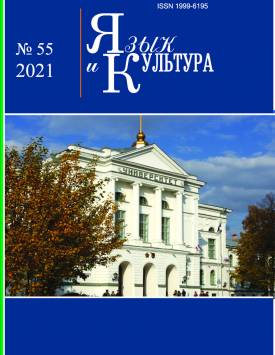World brands naming in China: Problems of linguistic translation into Chinese
The relevance of the study is due to the fact that the development strategy of the world market puts special requirements for the formation and promotion of brands. The analysis of the current state of the Chinese market shows that there are about 90 foreign brands included in the Top 20. Foreign brands of household goods, cosmetics, clothing and footwear, goods for children and equipment are popular in the Chinese market. The popularity of a foreign brand in China is associated not only with the high quality of products, the lack of similar products from Chinese manufacturers, but also with the particular qualities of branding in the Chinese language. Analysis of the language materials shows that brands that follow the Chinese naming tradition and have positively marked hieroglyphs are especially popular among Chinese consumers. When translating foreign brands into Chinese, transliteration and tracing techniques are regularly used, while the sound and semantics of a foreign brand are adapted to traditional Chinese culture. In the process of naming, discordant and unusual for the Chinese language for the combination of sounds are eliminated, the number of syllables in the brand name is reduced, the phonetic appearance of the original word is adapted. It was found that translation is rarely used in pure form of tracing; it is usually accompanied by semantic additions, insertions and transliteration. Particular attention is paid to the choice of signs that are used in the process of transliteration, with specific examples it is proved that successful brands use hieroglyphs with a "non-zero" meaning. In the process of brand translation, pictograms and ideograms associated with ancient cultural tradition and rituals are used, many signs in the structure new words already have a symbolic meaning associated with the positive qualities of a person, traditional Chinese morality, etiquette and rituals. Thus, concrete examples confirm the hypothesis that brand success is associated with marketing strategies and the translation of the name into Chinese. Branding is a complex regulated process related to the language and culture of the titular nation and the state as a whole, is closely related to the existing national tradition of naming, which allows regulating and guiding the process of entry of world brands into the Chinese market.
Keywords
brand,
naming,
marketing,
China,
translationAuthors
| Dubkova O.V. | Xi'an University of Foreign Languages | linuan12@mail.ru |
| Zakharova A.V. | Novosibirsk State Technical University | sah31zah@mail.ru |
Всего: 2
References
《85 的世界奢侈品牌已进入中国市场》《北京皮革 下》 2012年第1期第73页 / 85 % mirovykh lyuksovykh brendov vyshli na kitaiskii rynok // Behitszin pige, 1. Ch. 2. p. 73.
《世界名牌大全》中国纺织出版社 2014年10月1日 375页 / Luchshie brendy mira. Pekin: Izd-vo Chzhungo fanchzhi chuban'sheh. 375 p.
《最早进入中国的国际品牌之一 曾经黯然离场 如今却卷土重来》天高帝广 19-06-29 / Odin iz pervykh v Kitae mezhdunarodnykh brendov vozvrashchaetsya na kitaiskii rynok // Tyan'gaodi guan. 19-06-29. https://baijiahao.baidu.com/ (Accessed: 12.01.2020)
芦洋《国内影响消费者购买决策因素的研究综述》特区经济2016, (3). 第171-172页 / Lu Yan. Obzor faktorov, vliyayushchikh na prinyatie reshenii o pokupke potrebitel'skikh tovarov v Kitae // Osobaya ehkonomicheskaya zona, 3. pp. 171-172.
陈英 高张春 基于鞋类品牌再定位的命名研究 《经济研究导刊》2019 年第 3 期 总第 389 期 第48-50 90页. / Chehn' In, Gao Chanchun'. Brend-neiming: analiz nazvanii obuvnykh brendov // Ekonomicheskie issledovaniya, 3. pp. 48-50, 90.
丽叶 袁登华 卢泰宏 《双重文化背景下消费者自我观对国产/外国品牌评价的影响》现代管理科学 2014, 第5期 第98-100页。/ Chzhu Lie i dr. Vliyanie vzglyada potrebitelya na otechestvennuyu/inostrannuyu otsenku brenda v dvoinom kul'turnom fone // Sovremennyi menedzhment, 2 (5). pp. 98-100.
Аршавский Г.А. Особенности и формы продвижения иностранного бренда на рынке Китая // Маркетинговые коммуникации. 2015. № 5. С. 258-265.
Дубкова О.В., Лукина И.С. Трансляция мировых брендов средствами китайского языка // Вестник Новосибирского государственного университета. Серия: История, филология. 2012. Т. 11, № 4. С. 196-201.
Королева В. Особенности перевода названий брендов и слоганов на китайский язык // Studia Culturae. 2017. № 34. С. 67-74.
Крохалева К.А. Специфика адаптации названий иностранных брендов в китайском языке // Судьбы национальных культур в условиях глобализации : материалы III Междунар. науч. конф. Челябинск, 2015. С. 101-105.
Лю Шуйцин, Цзи Кайси. Перевод названия зарубежных брендов как способ продвижения в рекламном маркетинге // Экономика и бизнес: теория и практика. 2016. № 9. С. 101-103.
Рокицкая Е.М. Особенности перевода названий иностранных брендов на китайский язык // Иностранные языки: лингвистические и методические аспекты. 2014. № 28. С. 256-259.
Санданова Д.Б. Особенности бренд-нэйминга в Китае // Азиатско-Тихоокеанский регион: история и современность : материалы междунар. науч.-практ. конф. молодых ученых. Улан-Удэ, 2016. С. 283-285.
Ступкина М.В. Методы перевода названий брендов на китайский язык // Разработка и решение актуальных научных проблем: вопросы теории и практики : сб. науч. тр. по материалам Междунар. науч.-практ. конф. Смоленск, 2017. С. 166-168.
Урывская Т.А., Билялетдинова Д.Р. Бренд-нейминг: фонетическое заимствование иностранных торговых марок как инструмент воздействия на покупателей // Россия - Китай: история и культура : сб. ст. и докл. участников XI Междунар. науч.-практ. конф. Казань, 2018. С. 368-373.
Хаматова А.А., Кисель П.О. Особенности фонетического заимствования названий торговых марок в китайском языке // Вестник Новосибирского государственного университета. Серия: История, филология. 2017. Т. 16, № 4. С. 85-90.
《2020年-“十大”品牌排行榜》中国品牌网 / Top-10: Brend-list Kitaya - 2020 // Chzhungo pin'panvan. https://www.chinapp.com/best/index/ (Accessed: 02.02.2020).
Мезенцева С.С., Крайдер А.В. Особенности перевода названий брендов, компаний и товаров с русского языка на китайский // Язык и культура : сб. ст. XXVIII Между-нар. науч. конф. Томск, 2018. С. 459-466.
朴旭兰 中日语言特点及文化表现对比研究 《湖北函授大学学报》 2015年第6 期 第137-138页。/ Pyao Syuilan'. Sravnitel'noe issledovanie osobennostei kitaiskogo i yaponskogo yazykov i ikh proyavlenie v kul'ture // Vestnik Khubehiskogo universiteta zaochnogo obucheniya, 6. pp. 137-138.
陈雪 对汉语外来词的一点认识《陕西师范大学学报(哲学社会科学版)》 2009年第S1期 第135-137页。/ Chehn' Lehi. Chto nuzhno znat' o inostrannykh zaimstvovaniyakh v kitaiskom yazyke // Vestnik Shehn'siiskogo pedagogicheskogo universiteta (Seriya ‘Filosofskie i sotsial'nye nauki’), 1. pp. 135-137.
张燚 刘进平 张锐 负面危机事件对品牌来源国认知的影响-基于产品类型差异的调节作用 《江西社会科学》2016年第1期 第205-213页. Chzhan I, Lyu Tszin'pin, Chzhan Zhui. Vliyanie negativnykh krizisnykh sobytii na poznanie strany proiskhozhdeniya brenda: Reguliruyushchii effekt na osnove razlichii v tipe produkta // Sotsial'nye nauki provintsii Tszyansi, 1. pp. 205-213.
Bol'shoi kitaisko-russkii slovar' [Big Chinese-Russian dictionary] https://bkrs.info/ (Accessed: 27.07.2020).
《汉字字源》资源网 / Proiskhozhdenie kitaiskikh ieroglifov // Tszyyuan'van. http://www.fantiz5.com/ziyuan/ (Accessed: 25.07.2020).
《百度百科》百度百科网 / Ehntsiklopediya ‘BaidU’ // Baidu baikehvan. https://baike.baidu.com/ (Accessed: 28.07.2020).

